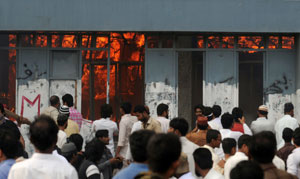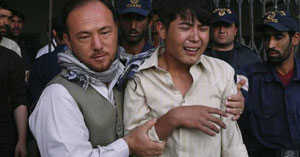Kingdom of Fear
By Ghazi Salahuddin | News & Politics | Opinion | Viewpoint | Published 13 years ago
When you go out to walk on the streets and mingle with the crowds, you begin to wonder if this is your own, your native land. You, somehow, feel intimidated because of how you think your worldview and your convictions may differ from those of the populace. It is so easy to imagine that most of those you see on the streets would readily be converted into a mob. And you are well aware of what the mob would do when it is exhorted by a fanatic.
In recent years, a high tide of religiosity and radicalism has swept across our lives. The passion with which the Islamists of a particular bent of mind impose their will is astounding. We had ample evidence of this outburst of anger in the aftermath of the assassination of Salmaan Taseer.
This episode alone should serve as the metaphor for a Pakistan that has been hijacked by religious militants. It was a time when even the leadership of the party of which Salmaan Taseer was a prominent figure acted in a cowardly fashion, in spite of the fact that Taseer’s stance on the blasphemy laws and his sympathy for a lowly Christian woman accused of committing an act of blasphemy conformed wholly to the party’s position. The PPP-led government, with its professedly secular allies, promptly decided not to take on the fanatics.
[Related Article: An Interview with Salmaan Taseer on blasphemy laws]
I shudder to think of the pall of fear that hung over the country as feverish support for Mumtaz Qadri, the assassin of Taseer, assumed the proportions of a tsunami. Qadri was eulogised as almost a saint, a heroic figure. Lawyers showered him with rose petals and a retired chief justice of the Lahore High Court offered to defend him in the court of law. The media was coerced into submission and was unable to be objectively report about the murder by a guard of the very person he was duty-bound to protect.
This is one snapshot to ponder. The closer you look at it, the deeper your heart would sink. In a situation like this, all avenues for sober thinking and a rational discourse get blocked. The problem is that like sequels of a blockbuster, the story is pushed forward on new locations and with, mostly, the same cast of characters. Hence, we have this example of events that took place on Ishq-e-Rasool Day in September this year.
Again, it was the PPP-led government that earmarked the Day and declared a national holiday to protest against a YouTube video that was initially ignored. It was the shoddy work of a crazy bunch of people and was universally condemned. Still, the issue prompted the leaders of this country to indulge their mindless policy of appeasement of religious elements.
We have seen how they, the wild mobs, observed this Day — and there was a preview on the eve of the national holiday in Islamabad. In Karachi, the high point was the attack on cinema houses, the secular temples that enshrine the deities of imagination and creativity. They do select their targets with care. The Taliban, for instance, are particularly averse to little girls going to school.
Take this as another window on a landscape that has the texture of the Dark Ages. Where do we — those who dream about a progressive and enlightened society — belong in this landscape? The irony here is that this country is believed to have been inspired by a different vision, irrespective of the contradictions that were inherent in its pursuit of a modern democracy for Muslims of South Asia.
At present, however, the Muslim identity of Pakistan is heavily polluted by an aversion to modern ideas and affection for militancy and sectarianism. The most damning indictment of today’s Pakistan is that a large number of Sunni Muslims do not accept Shias as Muslims. In Quetta, the Hazara Shia community is constantly targetedand the killings have the intimations of ethnic cleansing. Similarly, the sectarian strife in Gilgit-Baltistan has reached diabolical proportions. There have been spells of targeted killings of Shia professionals, doctors and lawyers in Karachi. This, in a country that was founded by a Shia, with an Ahmadi as its first foreign minister and a Hindu as its first law minister.
[Related Article: ‘Violence Against Shia Hazara Community Increases’]

Photo: AFP
A recent poll by the Pew Research Centre has discovered, unbelievably, that 50 percent of Sunnis in Pakistan accept Shias as Muslims — meaning that the other 50 percent do not. It is part of a larger investigation of the Shia-Sunni divide in Muslim countries and even though this sectarian divide is growing across the Muslim world and is also an extension of a conflict between Iran and some Arab countries, the recent surge in sectarian violence in Pakistan is another example of Pakistan straying away from its South Asian legacy. Unlike in other Muslim countries, South Asia during the Mughal rule was a refuge for the nobles of the two sects from persecution in their own countries — the Ottoman Empire and Iran. It was the continuation of this harmony that defined the character of the freedom movement that led to the creation of Pakistan.
The story of Pakistan, then, is how a country which may have been “insufficiently imagined” is traumatised by its crisis of identity. In some crucial ways, independence itself was rooted in violence. After all, the partition of the British India was attended by one of history’s most vicious communal killings and forced migrations. The leaders of both the Congress and the Muslim League seemed unaware of the primitive passions that their politics had nurtured at the popular level. Nor was there any perception of or plan for transfer of population. The bloodshed that took place in the Punjab may have largely conditioned the psyche of the two countries (nations?).
Pakistan’s intriguing bond with violence and extremism is, thus, congenital. It has been bolstered by some historical cataclysms as well as by choices made by our rulers in the name of national interest. India became the enemy and the military became the arbiter of our destiny, at the cost of social development . We embarked on a course that was marked by a sequence of disasters, including military interventions and the loss of the eastern wing of the country. We marched happily into the Afghan jihad, with its ultimately fatal consequences.
 That is how we have landed into the bonfire of our present crises, an assortment of threats to our survival. Extremism of the militants is effectively enhanced by the incompetence of the ruling coalition when it comes to maintaining the rule of law and dealing with ‘the enemy within.’ At another level, the quality of governance, reflected in the numerous off-the-record accounts of corruption in high places, has complicated the problem of arresting the dangerous drift.
That is how we have landed into the bonfire of our present crises, an assortment of threats to our survival. Extremism of the militants is effectively enhanced by the incompetence of the ruling coalition when it comes to maintaining the rule of law and dealing with ‘the enemy within.’ At another level, the quality of governance, reflected in the numerous off-the-record accounts of corruption in high places, has complicated the problem of arresting the dangerous drift.
[Related Article: ‘The Ideological Divide‘]
As a journalist, I am almost addicted to drawing people I meet, whether at a cocktail or in the bazaar, into a conversation about the current state of affairs to try to assemble different points of view. At times, I encounter an unsolicited torrent of grievances and anger. It is possible that people exaggerate or misinterpret events or wittingly promote their biases. But the cumulative impression that I get, my harvest of pain, is very instructive. Everywhere, I find a loss of hope. Even when someone insists on being optimistic and upbeat about our future prospects, all you need to do is to let him or her carry on and at some point, exasperation about what is happening in the country is bound to come to the surface.
Karachi, my circle of activity, may not be a very appropriate place to gauge the mood of the nation. It does feel a little different when I am in Lahore or Islamabad. Anyhow, Karachi can be very relevant because it also has a strange linkage with the lawless frontier in the north. The shadow of the Taliban has recently been detected in the dark muddle that has engulfed the city for a long time. It is the permanent address of organised crime, including that of a political dimension. It is also a scoreboard to record the daily count of targeted killings.
One measure of what living in Karachi at this time really means is to learn about the experiences of guests in a social or private gathering. I suggest a parlour game to find out the person who has been robbed at gunpoint the highest number of times. The champion in my family is a brother-in-law who has seen a gun pointed at him on five different occasions. Some others are four-timers.
[Related Article: ‘Karachi: City of Blights’]
Now, I have advisedly not mentioned Malala Yousafzai’s name so far. Hers is decidedly a very inspiring example in our collective struggle for sanity and peace. In the immediate aftermath of that horrible event, we all seemed ready for a dramatic shift in the government’s and the people’s position on militancy and extremism. A decisive military operation against the terrorists, who have found sanctuary in North Waziristan, was on the cards. Here was, it seemed, a turning point, the beginning of a new phase in our history.
But nothing of any great significance has happened during the past around four weeks. Yes, there is a sense of solidarity within the liberal and the enlightened segments of the population. Malala is still a potent symbol for social advancement in backward areas. At the same time, there are no hints of any change in the ruling ideas. The clerics and their fellow-travellers have succeeded in putting a spin on the Malala tragedy, invoking, for instance, the drone attacks and the supposed machinations of the western powers.
And this has obviously enhanced our sense of fear and insecurity in the context of the power that the radical Islamists can wield in Pakistan.
This article was originally published in the November issue.
Ghazi Salahuddin is a respected senior journalist in Pakistan. He currently works with the daily The News and the Geo television network.


